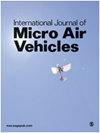晶格玻尔兹曼方法在微型飞行器相关问题中的应用
IF 1.5
4区 工程技术
Q2 ENGINEERING, AEROSPACE
引用次数: 11
摘要
对微型飞行器及其潜在任务的需求正在增加。无论是军事行动中的自由裁量权,还是民用中的噪声污染,改善微型飞行器螺旋桨的气动和声学性能都是一个需要实现的目标。微型和纳米飞行器的雷诺数在103到105之间。在这些条件下,由于流动粘性力的重要性增加,传统固定翼和旋转翼概念的空气动力学性能急剧下降,流动粘性力往往会增加阻力并促进流动分离,从而导致效率降低和可实现的最大升力降低。效率和升力的降低导致低耐久性和有限的有效载荷。数值模拟是一种潜在的解决方案,可以更好地理解这种低雷诺数流动,并提高微型飞行器的性能。在本文中,建议使用Lattice Boltzmann方法来回顾与微型飞行器相关的一些挑战。首先简要介绍了该方法,指出其优缺点。然后,将Lattice Boltzmann方法应用于三种不同的应用:单叶片转子的DNS、在地面效应下运行的转子的大涡模拟和针对声学性能优化的转子的大涡模拟。系统地与参考数据(Reynolds Averaged Navier-Stokes,DNS或实验数据)进行比较,以评估基于格子Boltzmann方法的预测的准确性。结果分析表明,如果网格分辨率选择得当(由于计算资源有限,这并不总是可能的),格子Boltzmann方法有很好的潜力预测平均空气动力学性能(扭矩和推力)。为了突出在这种转子中发生的一些物理流动现象,对每种应用都进行了湍流研究。还对不同的设计进行了研究,表明在低雷诺转子的空气动力学和气动声学性能方面仍有可能进行潜在的改进。本文章由计算机程序翻译,如有差异,请以英文原文为准。
Application of a lattice Boltzmann method to some challenges related to micro-air vehicles
The demand for micro-air vehicles is increasing as well as their potential missions. Whether for discretion in military operations or noise pollution in civilian use, the improvement of aerodynamic and acoustic performance of micro-air vehicles propeller is a goal to achieve. Micro- and nano-air vehicles operate at Reynolds numbers ranging from 103 to 105. In these conditions, the aerodynamic performance of conventional fixed and rotary wings concepts drastically decreases due to the increased importance of flow viscous forces that tend to increase drag and promote flow separation, which leads to reduced efficiency and reduced maximum achievable lift. Reduced efficiency and lift result in low endurance and limited payloads. The numerical simulation is a potential solution to better understand such low Reynolds number flows and to increase the micro-air vehicles’ performance. In this paper, it is proposed to review some challenges related to micro-air vehicles by using a Lattice-Boltzmann method. The method is first briefly presented, to point out its strengths and weaknesses. Lattice-Boltzmann method is then applied to three different applications: a DNS of a single blade rotor, a large eddy simulation of a rotor operating in-ground effect and a large eddy simulation of a rotor optimised for acoustic performance. A comparison with reference data (Reynolds Averaged Navier-Stokes, DNS or experimental data) is systematically done to assess the accuracy of lattice-Boltzmann method-based predictions. The analysis of results demonstrates that lattice-Boltzmann method has a good potential to predict the mean aerodynamic performance (torque and thrust) if the grid resolution is chosen adequately (which is not always possible due to limited computational resources). A study of the turbulent flow is conducted for each application in order to highlight some of the physical flow phenomena that take place in such rotors. Different designs are also investigated, showing that potential improvements are still possible in terms of aerodynamic and aero-acoustic performance of low-Reynolds rotors.
求助全文
通过发布文献求助,成功后即可免费获取论文全文。
去求助
来源期刊

International Journal of Micro Air Vehicles
ENGINEERING, AEROSPACE-
CiteScore
3.00
自引率
7.10%
发文量
13
审稿时长
>12 weeks
期刊介绍:
The role of the International Journal of Micro Air Vehicles is to provide the scientific and engineering community with a peer-reviewed open access journal dedicated to publishing high-quality technical articles summarizing both fundamental and applied research in the area of micro air vehicles.
 求助内容:
求助内容: 应助结果提醒方式:
应助结果提醒方式:


